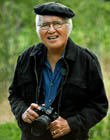|
|
 
|
|
Author
|
Topic: Happy 50th BWANA DEVIL!
|
Bernie Anderson Jr
Master Film Handler
Posts: 435
From: Woodbridge, New Jersey
Registered: Apr 2000
|
 posted 11-26-2002 08:53 AM
posted 11-26-2002 08:53 AM





50 years ago, on November 26, 1952, Arch Oboler's African adventure had its world premiere in Hollywood and Los Angeles at the Paramount theatres. Produced on a modest budget and photographed in dual-strip Natural Vision, this 3-D attraction was a tremendous success - "A Lion in Your Lap, A Lover in Your Arms."
Within 2 months, nearly every Hollywood studio had a 3-D feature in production. Warner Bros. began filming House of Wax; Paramount started re-shooting Sangaree (it had begun as a flat production); Universal-International started on It Came from Outer Space; RKO sent a crew to Mexico for Second Chance; Columbia began to rush Man in the Dark and Fort Ti through production; and MGM started on Arena. Even budget conscious Allied Artists got on the dimensional bandwagon with The Maze. The 3-D craze hit a fever pitch throughout the summer of 1953. At any one time, moviegoers had their choice of several first run 3-D films in all the major cities. By the fall, poor projection and falling grosses led to its first decline, and the introduction of CinemaScope in September ("The Modern Miracle You See Without the Use of Special Glasses") was another nail in the stereoscopic coffin.
3-D had a brief resurgence in the Winter with a number of high profile entries, including Hondo, Kiss Me Kate, Cease Fire, Miss Sadie Thompson and Creature from the Black Lagoon. However, by Spring of 1954, 3-D was pretty much a dead issue. The few remaining titles were released with little fanfare, or went out in standard 2-D only.
The 3-D craze was a quick one, but fondly remembered by those old enough to have experienced it first-hand. One technical point - all of these films were originally presented in the superior Polaroid dual-strip process. The single-strip red/blue anaglyph conversions were created in the seventies for various re-issues. There is a tremendous difference in quality between the 2 formats, and many people wrongly assume that these films were originally presented in the headache-inducing anaglyph system.
Fans of 3-D cinema can thank Arch Oboler and Sid Pink for taking a chance with a format that no major studio would touch. Happy 50th birthday Bwana Devil!
| IP: Logged
|
|
|
|
|
|
|
|
|
|
|
|
|
|
|
|
|
|
|
|
|
|
Paul Linfesty
Phenomenal Film Handler

Posts: 1383
From: Bakersfield, CA, USA
Registered: Nov 1999
|
 posted 11-27-2002 04:13 PM
posted 11-27-2002 04:13 PM




The single projection system for JAWS 3-D and other films of the era used the over-and-under approach. Basically, the frames were Tecniscope sized (2 perfs per image), so a standard 4-perf projection frame contained both frames. A special attachment to a "flat" lens both polarized each image and converged them. The resulting image will be SCOPE in appearance, but if the theatre is using their standard lenses with this, the scope image will be no wider than the theatre's normal FLAT setting (with significant masking top or bottom or both. Another varient was used for older films (House of Wax, Dial M for Murder). In this case, the two images wer side by side, employing a SCOPE squeeze. After being unsqueezed, the two images went through the same basic process on its way to the screen.
| IP: Logged
|
|
|
|
|
|
|
|
|
|
All times are Central (GMT -6:00)
|
|
Powered by Infopop Corporation
UBB.classicTM
6.3.1.2
The Film-Tech Forums are designed for various members related to the cinema industry to express their opinions, viewpoints and testimonials on various products, services and events based upon speculation, personal knowledge and factual information through use, therefore all views represented here allow no liability upon the publishers of this web site and the owners of said views assume no liability for any ill will resulting from these postings. The posts made here are for educational as well as entertainment purposes and as such anyone viewing this portion of the website must accept these views as statements of the author of that opinion
and agrees to release the authors from any and all liability.
|

 Home
Home
 Products
Products
 Store
Store
 Forum
Forum
 Warehouse
Warehouse
 Contact Us
Contact Us




 Printer-friendly view of this topic
Printer-friendly view of this topic











![[Smile]](smile.gif)

![[Wink]](wink.gif)





